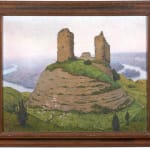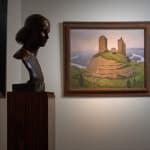Maurice Chabas
Further images
Maurice Chabas (French, 1862 - 1947), proclaimed himself "an animist", which means:
a seeker of the soul, of the individuality of beings, of the intimate thoughts they cherish, of their impulses..., "The great spirituality that emanates from it is fascinating.”.
This mysticism can be seen in his many landscapes, mainly inspired by Brittany, in his poetic compositions of contemplative young women and in his cosmic works, which have a highly personal, visionary approach. This first monograph devoted to Maurice Chabas provides an opportunity to rediscover one of the major artists of the Symbolist movement.
Maurice Chabas followed in the wake of philosophical currents, in particular idealism and mysticism. The artist was also tempted by neo-impressionist and synthetic techniques. Chabas' work shows the artist's multiple inspirations, both in terms of subjects (e.g. history, mythology, psychology, landscapes, portraits, ...) and the many artistic techniques applied (oils, charcoal, watercolours, white chalk, etc.). It is difficult to understand and appreciate his work without grasping his personality and gaining an insight into his 'social' action and convictions.
His work reveals the engaging personality of the artist, a great idealist who sincerely believed he was working to bring humanity to perfection, to achieve eternal peace and who made his work a mission.
Maurice Chabas was a highly visible figure from the end of the nineteenth century until his deliberate isolation in a kind of contemplative retreat a few years before his death in 1947. Not only was he a (sometimes overly) prolific painter but he also held countless positions in the institutional world of art and social and humanist action in general (Salons, artists' societies, commissions, philanthropy, etc.) and was a major figure in the artistic and social circles of his day. Today, it is hard to imagine the place he held in the most advanced and recognised circles. Myriam de Palma found a photograph, taken by a National Geographic reporter, showing the painter in the company of the astronomer Camille Flammarion (1842-1925), the pioneer of modern dance and theatrical lighting Loïe Fuller (1862-1928), the Impressionist and Symbolist painter Jean-Françis Auburtin (1860-1930), the renowned sculptor Auguste Rodin (1840-1917) and his faithful model, mistress and housekeeper for 50 years Rose Beuret, whom he married in January 1917 (two weeks before his death and ten months before hers on 17 November 1917). This is just one example of his strong presence in his time.
He was born into a family of cultured shopkeepers whose father was an amateur painter in his spare time, who encouraged the vocation of his two sons Maurice and Paul Émile, since his eldest son took over the family business.
They were soon admitted to the Académie Julian, where their teachers included Tony Robert-Fleury (1837-1911), William Bouguereau (1825-1905), Gustave Boulanger (1824-1888), Jules Lefebvre (1836-1911) and fellow student Jules Adler (1865-1952).
Both an easel painter and a monumental artist, he was highly productive.
His first exhibition was at the Salon des Artistes Français in 1885, where he exhibited until 1913. There he discovered Pierre Puvis de Chavannes (1824-1898), whose style and subjects influenced him. He exhibited widely, notably at the Salon des Amis des Beaux-Arts in Nantes from 1890 to 1907 and at various Christian-inspired salons. As a sensitive and mystical artist, he adhered to the thoughts developed by Sâr Joséphin Péladan, a modern Rosicrucian and founder of the mystical Order of the Rose+Croix and assimilated many of his ideas including his vision of the artist as a spontaneously developed initiate whose mission was to send light, spirituality and mysticism into the world. Chabas took part in all the Rose+Croix ' salons from 1892 to 1897. There he met Alphonse Osbert (1857-1939), some of whose works were similar in inspiration and technique and who was a member of the Groupe des Inquiets (later called "The Eclectic") which exhibited in 1894. His Symbolist paintings, which were still academic in style, were adorned with titles evocative of a mystical ideal that he thought was necessary for human beings: "Celsa" ("Ecstatic Phase") or "Mélété" ("Evening Melody" - "a feeling of calm and contemplation").
His fame spread and in 1895 his work was exhibited at the Galerie des Arts Réunis (Avenue de l'Opéra) in Paris. Divisionism led him to adopt a less classical style for his dreamy landscapes and ethereal skies. At the same time he created a number of decorations including one for the Montrouge town hall in 1884 and one for the 14th arrondissement of Paris in 1889.
In 1895, he was commissioned to decorate the buffet at the Gare de Lyon-Perrache, including 4 large canvases depicting “Allegories to the glory of Lyon's silk industry”. These paintings seem to have disappeared during the renovation works. In 1898 he took part in the competition to decorate the marriage hall at Vincennes town hall (which he also won). This set of 7 marouffled canvases were mounted in 1902.
From 1900 he moved to 3 Villa Sainte-Foy in Neuilly-sur-Seine. There he he transformed his studio into a salon where Léon Bloy (1846-1917), a Catholic writer, met him. The philosopher, sociologist and anthropologist Lucien Lévy-Bruhl (1857-1939); Père Antonin Sertillanges (1863-1948) who was then secretary of the "Revue Biblique", Camille Flammarion (1842-1925), astronomer and spiritualist; Maurice Maeterlinck (1862-1949), Catholic writer and future winner of the Nobel Prize for Literature (1911); Charles Richet (1850-1935), professor of medicine and future winner of the Nobel Prize for Medicine (1913); Sâr Joséphin Péladan, modern Rosicrucian, mystical and occultist writer and founder of the Mystical Order of the Rose+Croix and the Salon Rose+Croix; the author René Guénon (1886-1951), an unclassifiable figure in the intellectual history of the twentieth century; Édouard Schuré (1841-1921), writer, philosopher and musicologist and other noteworthy figures, were often present in his Chabas' studio.
That same year (1900)Chabas was commissioned by Mr Dervillé, then director of the Paris-Lyon-Méditerranée (PLM) railway company, through the intermediary of its architect in charge of decoration, Mr Marius Toudoire, to paint a canvas titled "Marseille" for the grand hall of the restaurant "Le Train Bleu" at the Gare de Lyon in Paris,
In 1915, in Belgium, he met Gabrielle Storms-Castelot, born in Antwerp in 1888 and mother of two sons: André Castelot, who became a renowned historian and Jacques Castelot, who became an actor. They later had a daughter, Germaine Chanteaud-Chabas, who also became an astronomy enthusiast. When the war broke out, they left Belgium to take refuge in England. In the last quarter of 1914 they returned to 42 Rue de Lubeck in Paris.
From then on he moved towards stylistic simplification, subject to spiritual and cosmic thought, which led to total abstraction around 1920. The Galerie Devambez, where Chabas exhibited in 1913, published a collection of lithographs accompanied by a text by the painter entitled "Vers l'Amour Suprême" ("Towards Supreme Love"), intended to uplift souls and draw them towards the higher states of "Universal Life".
In 1923, Maurice Chabas co-founded the Salon des Tuileries with the Australian painter Bessie Ellen Davidson (1879-1965) and the French painter, engraver, sculptor and decorator Charles Dufresne (1876-1938). On June 15 that year, he took part in the lunch organised by Ambroise Vollard for the first and only literary prize for painters, the "Prix des Peintres", whose winner was the writer, poet and philosopher Paul Valéry (1871-1945). The jury included painters, writers and poets Louise Hervieu, Jacqueline Marval and Marie Laurencin (the only women among the male artists), Georges Besson, Bonnard, Boudelle, Maurice Chabas, Chagall, Maurice Denis, Derain, Forain, Gervex, Laprade, Matisse, Picasso, Rouault, Rousse, Sem, Signac, Van Dongen, Vlaminck and Vuillard.
Later on he would also become a member of the Salon d'Automne, la Société Idéaliste and la Société Moderne and exhibited at the Carnegie Institute of Pittsburgh.
He remained faithful to an exalted spiritualism that he still defended in 1935 in a letter to the director of the Musée des Beaux-Arts, preserved in the National Archives: “Humanity today needs a higher ideal. We can no longer live in the imbalance that creates the disharmony that leads to destruction and death. We need the Spirit to give life to matter and works."
It was his friend and writer Alphonse van Bredenbeck de Châteaubriant (1877-1951) who wrote the preface to his work “Sur les Routes du Lot”, which he undertook in 1935 at the request of another friend Anatole de Monzie (1876-1947), former minister of finance and national education.
1937 was the year his younger brother Paul died. It was during these years that he met Jean Marchand, known as "Mercator", with whom he had discussions of a spiritual nature.
Towards the end of his life, he painted almost exclusively religious subjects, with a great misty luminosity that tended towards the abstract. He saw virtually no one and lived in seclusion, far from his family. He died on 11 December 1947 in the rue de la Paroisse in Versailles, aged 85, having been awarded the Chevalier de la Légion d'Honneur.
Maurice Chabas (1862-1947) has not been the subject of a monographic exhibition since the Galleria Museum's retrospective in 1951. The Musée des Beaux-Arts in Pont-Aven in turn exhibited other works by the artist from 10 October 2009 to 3 January 2010. The museum brought together around sixty works by the artist. This monographic exhibition was repeated by the Musée de Bourgoin-Jallieu, in Bourgoin-Jallieu, Isère, from 27 April to 31 August 2010. The Pont-Aven exhibition was the result of work by Myriam de Palma, who wrote her doctoral thesis on the artist at the University of Paris IV-Sorbonne. Although his works had occasionally featured in exhibitions on the Symbolist movement, we had to wait for this new research to hear about this atypical painter again in a more scientific way. A paper presented to the Société de l'Histoire de l'Art français in 2004 followed by a fine article in the catalogue of the exhibition conceived by Professor Arnauld Pierre Cosmos "En busca de los orígenes", de Kupka à Kubrick in 2008 (Museo Oscar Dominguez, Santa Cruz de Tenerife), certainly whetted the appetite of lovers of Symbolist painting as did the presentation of Pont-Aven.
Literature
Myriam de Palma, Maurice Chabas, peintre et messager spirituel (1862-1947), Somogy Éditions d'art, 2009; Jean-Jacques Lévêque, - 1892 : Le Salon de la Rose-Croix, une secte - La Belle Époque, ACR Édition internationale, Courbevoie, 1991, p. 234; Jean-David Jumeau-Lafond, Les Peintres de l'âme, le Symbolisme idéaliste en France, (catalogue de l'exposition éponyme au Musée d'Ixelles), 1999.







